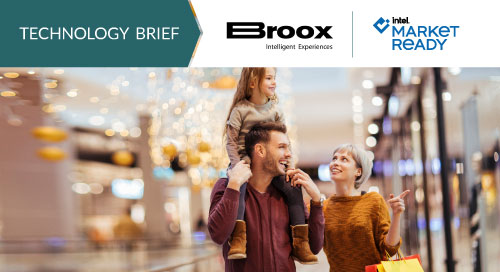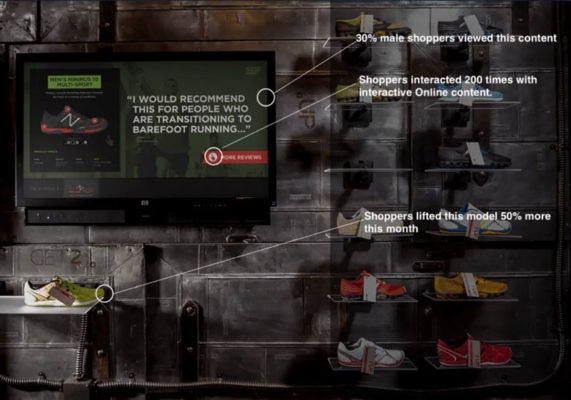AI and CV Transform Digital Interactions

As online commerce shifts into overdrive, shoppers need a compelling reason to trek to physical stores. Interactive displays could do the trick. Picture a giant screen where people can play games, watch a parade of psychedelic-colored blossoms drift by, or snap a photo of their kids petting a virtual leopard.
Scenarios like these give shoppers an experience they won’t soon forget, while the technology behind them lets retailers capture valuable customer information. Although they’re a great draw, interactive installations are often expensive for retailers to install and difficult to manage.
But new solutions are emerging to lower costs and make them easier to use.
Unifying Digital Display Technology
Interactive installations include a wide array of equipment. Retailers may set up several screens equipped with computer vision cameras, which detect shoppers’ age and gender and show appropriate real-time promotions. They may also use QR codes, or place RFID or NFC sensors at point-of-sale exhibits, triggering product information to be shown when a customer lifts an item from the shelf.
“If you pick up a sneaker, you can learn about its features and find out, for example, if it provides traction in the rain,” says Julià Carboneras Girgas, chief marketing officer of interactive software provider Broox. “If you pick up two sneakers, you can compare their features.”
But what’s fun for shoppers is a headache for retailers and systems integrators. The hardware and software needed to deploy interactive systems are produced by different manufacturers, requiring multiple leasing or purchase contracts. Setting it all up and managing it is time-consuming and expensive. In addition, data from the hardware is sent to separate platforms that don’t communicate with one another – or with the marketing systems that retailers use.
“Retailers have dozens of platforms and dashboards to manage. You cannot mix the RFID data with the computer vision data, and you cannot put any of it into Marketo or Salesforce or Google Analytics,” says Albert Minguell Colomé, founder of Broox. “All our systems integrators and retailer partners were telling us, “Please give us something we can afford and manage,” adds Carboneras.
In response, Broox developed a “phygital” software platform that unites the in-person shopping experience with the digital world (Figure 1).

Broox builds its software infrastructure with the Intel® OpenVINO™ Toolkit, which speeds integration of AI capabilities and enables cameras, sensors, and other interactive technology to speak the same language. Hardware components send data feeds to a single platform that’s easy for retailers to manage. Sensitive customer information such as facial characteristics is processed on-site and with only metadata sent to the platform’s cloud.
The Broox platform also integrates with marketing analytics software, allowing retailers to do a deep dive into customer preferences and grow profits with cross-channel campaigns. Retailers who personalize the customer experience across physical and digital channels can achieve a 5% to 15% revenue increase, according to McKinsey.
“By using this platform, retailers can focus on creating content and forget about the technology that scares them,” Minguell says.
“By using this platform, retailers can focus on creating content and forget about the technology that scares them.” Albert Minguell Colomé, Broox Founder
Lowering the Cost of AI Technologies
The Broox SaaS payment model helps allay another retailer fear—excessive costs.
“We work with customers to determine their needs,” Carboneras says. “We’ll say, ‘For this idea, you’ll need the camera and the media player, and here is the monthly cost of that solution.’”
The platform also lowers expenses by working with Intel® NUC PCs. “Affordable PCs with a small footprint are exactly what our systems integrators are demanding. If software only runs on laptops that cost a thousand euros, nobody can roll it out in a hundred stores with 200 displays because it’s super-expensive,” Minguell explains.
Retail Analytics Offer Choices
Adding online options to point-of-sale transactions provides flexibility for customers, who are increasingly using stores as showrooms.
“Teenagers are famous for saying, ‘Let’s go to the shopping mall to buy something online,’” Carboneras says.
When a customer lifts a product from a smart shelf, scans information with their phones, but then doesn’t buy it, the retailer can send targeted promotions and track conversions through cookies. And someone who wants an item that’s not available in the store can click to have it delivered to their home the next day.
“Retailers can see that the online purchase was initiated in a store and learn the performance of that point of sale,” Minguell says. Broox is currently working on technology that will allow customers to purchase both in-store and ecommerce items in a single transaction.
Digital Experiences Revive a Mall
A shopping mall in Andorra illustrates how interactive experiences can spark visitor interest and boost profits. The mall connected existing security cameras and indoor and outdoor screens to the Broox platform. A new computer vision system captured visitor counts and customer demographics as screens displayed augmented-reality images of animals. The indoor screen also flashed a QR code (Video 1).
People who downloaded the code to their mobile phones could snap photos as their kids frolicked with the animals. During the pandemic Christmas season, the mall switched the display to show Santa, so kids could have virtual visits.
“Previously, the screens were displaying boring, static images,” Minguell says. “The platform allowed them to create magical content and gain some nice analytics about results.”
Retailers gained a trove of customer information. In three weeks, the technology attracted 30,000 interactions. It increased mall entry by 7% and captured 4,500 new email addresses, becoming the best-performing campaign in the mall’s history. “And that was during the pandemic,” Minguell says.
As online shopping grows, Minguell expects to see fewer traditional and more experiential flagship stores. “Stores will become places where people don’t necessarily go to buy products, but to have a playful, enjoyable experience,” he says. “You can learn a lot from your customers when they interact with your brand.”